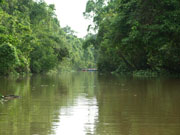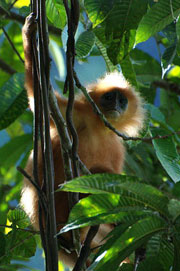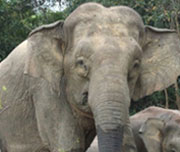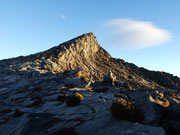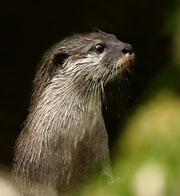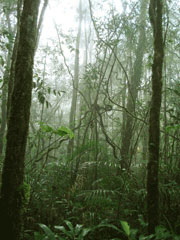Whether you long to see the majestic orangutan in its forest home, witness hatchling turtles make their first splash into the sea, or experience what it feels like to be in a luxuriant tropical forest, Borneo offers this and so much more. Our Rainforest, Rivers and Islands trip combines some of the best elements of Borneo's wildlife and wilderness locations, leading you through rainforests and coastal habitats, mountains, rivers and islands and gives you some of the best chances to see wild Bornean orangutans and elephants in their natural forest homes.
Although it may seem difficult to put into context just how rich Borneo is in terms of its plants and animals, over 350 species of flora and fauna were newly described by science in the decade following the mid 90's. There is also an estimated 221 species of mammal, 420 species of bird, more than 3,000 types of tree and over 15,000 species of flowering plants. With its many remote forests and immense rivers, the island of Borneo can deliver a real feeling of exploration into the unknown and a sense of natural wonder for those lucky enough to visit.
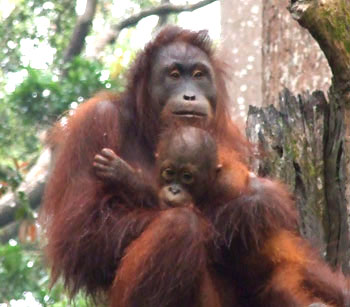
The iconic face of Borneo's most famous species of wildlife, the Orangutan
Your journey starts with acclimatisation in Kota Kinabalu, but with the option to explore the Tunku Abdul Rahman Marine Park and thickly forested islands of Gaya and Manukan; fringed with sandy beaches. Alternatively, if you are looking for a spot of adventure you can start your time in Borneo with an exciting white water rafting descent of the Padas River which flows through the rugged jungle covered Crocker Range.
Venturing next into the Kabili-Sepilok Forest Reserve, where 60-80 Bornean orangutans are living within an area of rich primary lowland forest, you have a good chance of encountering these enigmatic but endangered great apes in their natural forest home. The reserve is also the site of one of the world's most famous wildlife rehabilitation and conservation programmes: the Sepilok Orangutan Rehabilitation Centre. Young, captive or abandoned orangutans, orphans of deforestation, are being helped by highly trained and motivated staff to readjust to a life in the wild.
From Sepilok, we take you to the Turtle Island Park. This conservation programme is run by the Sabah Parks authorities, where rangers work to protect green and hawksbill turtles, both of which are listed as 'endangered' on the IUCN Red List. Whilst here, you may be able to witness green and hawksbill turtles leaving their watery world to nest on the beaches on this tiny island. You may also see rangers transferring the eggs to the safety of hatcheries and witness young turtles making their very first splash into the sea after hatching.
From the sea we next take you to explore one of Borneo's most diverse and wildlife intense habitats: the riverine forest and oxbow lakes of the Kinabatangan - Sabah's longest river - within the Lower Kinabatangan Wildlife Sanctuary. The lower reaches of this river form an ecosystem of almost unparalleled richness, with ten primate species, including one of the best opportunities to encounter gibbons and bizarre proboscis monkeys playing in the riparian forest canopy. If you are willing to spend an extra day or two, then we can take you to explore deeper in search of wild orangutans and wild Asian elephants. We can also take you to an ideal spot from which to observe the daily exodus of two million bats which live inside the Gomantong Caves.
|
The next stage of your journey is to one (or more) of three major rainforest areas within Sabah: Tabin, Danum and the Maliau Basin. Here is a quick introduction to all three, with links to further details to each area. |
A completely different ecosystem within Borneo is the national park surrounding Mount Kinabalu, the highest peak in South East Asia. For those who take our 13 day version of this journey, the focus is on exploring the outstanding array of flora and fauna in the mountain forest habitat of this, Malaysia's first UNESCO World Heritage Site. There are more than 800 species of orchid in these forests, as well as giant pitcher plants, flesh eating spy plants large enough to consume a rat, and opportunities to see the once in 100 year flowering of the Rafflesia. This is the world's largest flower, known for its pungent smell of rotting flesh - a feature which gives its local name as 'the corpse flower'.
The more intrepid can attempt the 4,000m climb to the summit and take in the magnificent views of Borneo far below as the sun rises.
This fascinating experience of wild Borneo and its wildlife is enhanced by the guidance and talks provided by expert local naturalists who can share their passion for this island's nature and its conservation.
Photographs kindly provided by David Slater, Charlotte Caffrey, Ralph Pannell, Alan Oh, SMART, Lawrence Lee, Nick Bramley, Albert Teo and PSR
Borneo & Malaysia Tailor Made & Small Group Travel - Sabah deforestation - sukau Palm Oil - Tropical Rainforest Rivers & Islands
Dates
|
Prices (valid to 31st Mar 2017) 12 days incorporating Tabin £1,990 pp sharing To climb Mount Kinabalu add 1 day & £215 For Danum Valley option in place of Tabin add £265 pp Option for additional day & night for Wild Orangutan or Wild Elephant Search add £225 Single supplements: please Contact Us Our prices include Our prices exclude Standard of Accommodation Activity Level |



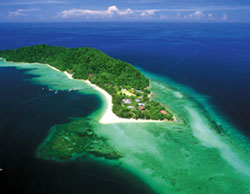

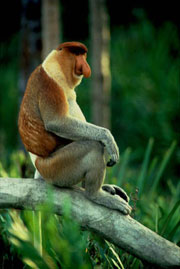
edited180.jpg)

